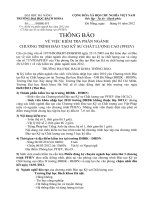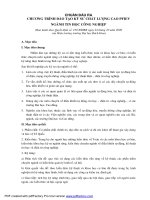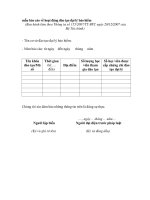Báo cáo về chương trình đào tạo kỹ năng dịch thuật Interpreting skills training report
Bạn đang xem bản rút gọn của tài liệu. Xem và tải ngay bản đầy đủ của tài liệu tại đây (365.28 KB, 49 trang )
2006
Report prepared for
AMEP & Language
Policy
Department of
Immigration and
Multicultural Affairs
by
School of Languages,
Cultures and
Linguistics
Monash University
B
ASIC
I
NTERPRETING
S
KILLS
T
RAINING
Coordination of Basic Interpreting Skills Training for Potential
Interpreters in Small and Emerging Community Languages
2
T
ABLE OF
C
ONTENTS
Acronyms 4
Section 1: Project Overview 5
1.1 Background 5
1.2 Research to date 6
1.3 Aims of project 7
1.4 Proposal for course delivery 8
Section 2: Methodology 9
2.1 Selection of institutions 9
2.2 Submissions from course providers 9
2.3 Selection of course providers 10
Section 3: Course Delivery 12
3.1 Course Providers 12
3.2 Course comparison 12
3.3 Duration of Courses 15
Section 4: Selection of candidates 16
4.1 Testing candidates 18
4.2 Assessment of candidates 19
4.3 Support for Category 4 candidates 20
4.4 Summary of the testing process 20
4.5 Invitation to participate in course 22
4.6 Additional testing and pre-enrolment events 22
4.7 Enrolments 23
Section 5: Analysis and Evaluation of Course Delivery 25
5.1 Aims and objectives of courses 25
5.2 Mode of delivery 26
5.3 Timetabling 27
Section 6: Analysis and evaluation of course content 29
3
6.1 General learning 29
6.2 Social and cultural aspects and ethics of interpreting
in an Australian context 29
6.3 Interpreting techniques, language skills for
interpreting 30
6.4 Work experience 30
6.5 English Language Component 31
6.6 Comments from students 31
Section 7: NAATI Accreditation/ Recognition Process 32
7.1 Summary of results nationally 32
Section 8: Identification of Problem Areas 35
8.1 Recruitment 35
8.2 Testing 35
8.3 Time constraints 37
8.4 Attendance 37
8.5 NAATI testing 38
Section 9: Recommendations for Future Training Initiatives. 39
9.1 Recruitment and Testing 39
9.2 Length of course 40
9.3 Social and cultural aspects and ethics of interpreting
in an Australian context 41
9.4 Extension English 41
9.5 Incorporation of LOTE 42
9.6 Work experience and job skills development 42
Section 10: Model for intensive course on Basic Interpreting
Skills Training 44
Concluding Remarks 48
References 49
4
A
CRONYMS
ABS Australian Bureau of Statistics
AMEP Adult Migrant English Program
AMES Adult Multicultural Education Services
AUSIT Australian Institute of Interpreters and
Translators Incorporated
CALD Culturally and Linguistically Diverse
ESL English as a Second Language
DIMA Department of Immigration and Multicultural
Affairs
ISLPR International Second Language Proficiency
Ratings
LOTE Language Other Than English
MRC Migrant Resource Centre
NAATI National Accreditation Authority for Translators
and Interpreters
NMIT Northern Melbourne Institute of TAFE
PPI Paraprofessional Interpreting
RMIT Royal Melbourne Institute of Technology
RTO Registered Training Organisation
TAFE NSW TAFE New South Wales
TAFESA TAFE South Australialogy Tran
T&I Translator and Interpreter (Translation and
Interpreting)
VOMA Victorian Office of Multicultural Affairs
5
S
ECTION
1:
P
ROJECT
O
VERVIEW
1.1
B
A C K G RO UN D
In the Report of the Review of Settlement Services for
Migrants and Humanitarian Entrants (May 2003) both public
consultations and submissions to the review suggested
targeting the continuing shortage of interpreters in small and
emerging languages through subsidies to pay NAATI
accreditation or recognition fees for potential interpreters,
particularly humanitarian entrants who may otherwise be
unable to afford the costs (Recommendation 53). The report
made the general comment that interpreters are in short
supply or not available in many of the newly arrived
people’s languages. The report also stated that public
consultations and submissions suggested that the level of
interpreter training, including training in the field of
interpreter-ethics, be increased (DIMA 2003, pp 278-86).
DIMA’s National Report on Settlement Needs of New Arrivals
2006 states that from 2005 to 2006, the offshore Humanitarian
Program has focused on resettling people from Africa, the
Middle East and South West Asia; a similar focus would be
maintained from 2006-07, with a small decrease in numbers
from Africa and an increase in numbers from South East Asia.
National small and emerging communities identified for the
2005-06 program year were the Afghan, Eritrean, Ethiopian,
Somali, Sudanese and Kurdish communities. For the 2006-07
program year, the communities will be the Burundian,
Liberian, Sierra Leonean, Congolese, Rwandan and
Ethiopian communities. The top ten languages from the
Humanitarian Program 2001-05 indicate those for which
there is an identifiable demand (current and projected) for
interpreters, including:
• Arabic
• Dari
• African languages (excl. Nth African)
• Serbian
• Dinka
6
• Persian/Farsi/Dari
• Assyrian (incl. Aramaic)
• Bosnian
• English
(DIMA 2006, pp. 8-9)
The report also highlights several issues regarding the
settlement needs of these groups, including (but not limited
to):
• Limited or no experience of schooling
• Illiteracy in their own language
• Unfamiliarity with modern health practices
• No experience participating in a formal economy
• Unfamiliarity with technology, including in workplaces
• Unfamiliarity with the values and practices of
participatory democracy, including rights,
responsibilities, and the role of different authorities
(DIMA 2006, pp. 11-12)
1.2
R
E S EA RC H TO D A T E
In 2005, DIMA contacted Monash University to conduct
research under the heading of ‘Developing Interpreting Skills
Training for Potential Interpreters in Small and Emerging
Community Languages’. The final report ‘Framework for
Delivery of Basic Training and Designation of Training
Pathways’ identified an urgent need for curriculum
development in the area of basic interpreting skills training in
small and emerging languages. One of the key
recommendations of this report was to establish courses
providing foundation skills in interpreting, aimed at speakers
of small and emerging languages, most of whom are also
new arrivals to Australia. The report recommended the
implementation of a pilot training initiative with a view to
increasing the number of interpreters providing language
services to small and emerging language communities.
7
In early 2006, DIMA asked Monash University to coordinate a
further research phase that would activate the training
initiative recommended in Phase 1, ensuring:
• Consistency in the testing and selection process of
potential trainees; and
• Quality assurance with regard to course delivery.
Researchers were asked to coordinate courses in basic
interpreting skills training for potential interpreters in small
and emerging community languages, focusing on three key
phases:
1. Test development (testing English and LOTE skills)
2. English language testing
3. Recommendation of training pathways
1.3
A
IM S O F P RO JEC T
The aims of the second phase of the research: ‘Coordination
of Basic Interpreting Skills Training for Potential Interpreters in
Small and Emerging Community Languages’ were as
follows:
a) To coordinate the implementation of the framework,
including:
• developing the testing system, instruments and
reporting formats
• testing of individuals identified by DIMA as potential
trainees
• recommending the appropriate training pathways for
individuals based on one of three categories of
assessment
• negotiating the delivery of intensive English Language
Enhancement Courses (equivalent to Certificate III)
and /or Interpreter Foundation Courses (equivalent to
Certificate IV) with selected TAFEs or Registered
Training Organisations in relevant states and territories
8
• proposing terms and conditions for contractual
arrangements between each TAFE or RTO and DIMA
for the delivery of agreed courses
• monitoring the progress of trainees and reporting
back to DIMA; and
b) To undertake short and longer term evaluation of the
framework model.
1.4
P
RO P O SAL F O R C OUR S E D EL IV E RY
Preliminary data provided by DIMA, combined with the
findings collected in Phase 1 of the project in 2005,
suggested that Victoria, South Australia, New South Wales
and Western Australia would have sufficient numbers of
potential trainees to warrant the delivery of intensive training
modules.
Monash University coordinated the selection of potential
course providers, based on the following criteria:
• Indicative costings provided by each institution
• Experience in running interpreter-related training
programs.
• Location and accessibility of the training institution
It was proposed that institutions be funded by DIMA for the
total cost of running the courses based on minimum
enrolment figures of 15 students. This would ensure that
courses could still run regardless of how many students
eventually enrolled.
9
S
ECTION
2:
M
ETHODOLOGY
2.1
S
ELEC TI O N O F I N S T I TU T IO N S
Monash identified seven institutions, based on the overview
of ‘Delivery Frameworks Currently in Place’ that appeared in
the report for Phase 1 (Wilson et al, p.18). The review
established the number and nature of translating and
interpreting courses offered Australia-wide as delivered by
registered training organisations. For the purposes of Phase 2
of the project, Monash compiled a list of providers with the
relevant expertise (i.e. prior experience in delivery of basic
interpreting training courses) to deliver the proposed pilot
course.
T
ABLE
1:
P
RELIMI NARY LIST OF C OURSE PROVIDERS
State Name/s of Course Provider
Victoria
• Kangan Batman TAFE
• Northern Melbourne Institute of TAFE (NMIT)
South Australia
• TAFESA
• LM Training
New South Wales
• TAFE NSW-Sydney Institute
Western Australia
• Central TAFE
• West Coast College of TAFE
2.2
S
U B M I S SI O NS F R O M C O URS E P RO V I D E RS
Monash requested written submissions from each course
provider outlining proposed training units/modules, length of
delivery (including hours per week) and the cost of delivery.
A short, intensive course was required, of around 100-150
hours duration, run over 8 to 12 weeks. The course would
provide basic training in interpreting and language aide
work, including intercultural communication skills and an
10
understanding of professional and ethical practice, as well
as a work experience placement and preparation for the
NAATI exam at Paraprofessional Level.
LM Training was excluded from this process as, after further
scrutiny, it became evident that their course did not
correspond to all of the requirements set out by DIMA. West
Coast TAFE did not submit a proposal because they felt that
there was insufficient time available to develop a suitable
course.
2.3
S
ELEC TI O N O F C OU R S E P R OV ID ER S
The submissions were assessed by Monash according to the
following criteria:
• Capacity to deliver an intensive module
• Preparation of course materials suitable for an
intensive module
• Potential to provide a national model that could be
used effectively to train groups of candidates in small
and emerging communities
• Cost of course delivery
• Location and accessibility by public transport
Subsequently, Monash selected NMIT (Victoria), TAFESA
(South Australia) and TAFE NSW-Sydney Institute (New South
Wales). These submissions were deemed the most
comprehensive and best aligned to the objectives of the
project. The submission from Kangan Batman TAFE was
considered unsuitable due to a lack of any prior experience
in running an interpreter training course and lack of
appropriate teaching staff, while Central TAFE was deemed
too costly. DIMA confirmed delivery with the selected RTOs
and made the appropriate contractual arrangements with
the respective course coordinators.
11
In Western Australia, it proved impossible to present
candidates with a course similar to those offered in other
states. After the two main providers, Central TAFE and West
Coast TAFE, had to be excluded because of time and cost-
related concerns, Monash contacted NAATI WA, who
agreed to provide a ‘mini-course’ based on a series of
NAATI workshops on basic interpreting skills and preparation
for NAATI examinations. Because of the delayed responses
from the Western Australian TAFEs, NAATI was contacted at
a much later stage than the course providers in other states.
As a result, the course run in WA was noticeably shorter (5
weeks and 36 contact hours) than in other states (9-12
weeks and 144-154 contact hours). However, the focus
remained in line with the requirements of the project. Given
that one of the desired outcomes of the project was to
prepare students for NAATI accreditation/recognition, it was
felt that the course proposed by NAATI was a particularly
appropriate course model for the pilot.
12
S
ECTION
3:
C
OURSE
D
ELIVERY
3.1
C
OU R SE
P
RO V I D E R S
The final list of course providers appears below.
T
ABLE
2:
F
INAL
L
IST OF
C
OURSE
P
ROVIDERS
City/State Course Provider Campus/Location Course Coordinator/ Head
Teacher
Melbourne, Victoria
Northern
Melbourne Institute
of TAFE (NMIT)
Collingwood
Campus
Anne Giddens
Adelaide, South
Australia
TAFESA
Adelaide City
Campus
Magdalena Rowan
Sydney, New South
Wales
TAFE NSW
Sydney Institute
Petersham
College, West
Street Campus
Bob Webb
Toula Markos
Perth, Western
Australia
NAATI WA
NAATI WA Head
Office, Perth
Valerie van
Loggerenberg
Dr Wolfgang Frick
3.2
C
OU R SE CO MP A R I SO N
The following table reflects the main components of courses
delivered in all four states, based on information supplied by
the course providers. It should be noted that although there
is some variation in delivery, the course providers adopted a
common approach to content.
13
T
ABLE
3:
C
OURSE COMPARISON OVER ALL FOUR STATES
Course title Aims & Objectives Duration Module & Course
Details
Entry level,
Articulation & Credit
Transfer
NMIT
Intensive Interpreter
preparation program
for New and
Emerging Languages
To develop students’
English skills to level
from which they could
access higher-level
(Diploma) further
education + training
opportunities
To develop
understanding of
requirements of
professional role of
T&Is. Course prepares
students for vocational
pathway. Aimed at
students who have an
interest in a career in
T&I field.
To get overview of
career & career
opportunities in T&I,
and other language
related fields
Full-time 16 hours
p/w, 3 days p/w
delivered over 9 wks
with 2 wk work
experience
placement. Total
144 hours.
Course hours
negotiated to fit with
student’s
responsibilities
(family etc).
Delivered through Cert
IV in ESL Further
Study (ESL
Frameworks) English
for Interpreting &
Translating
4 streams:
Professional, Further
Study, Employment
and Access
Core modules of
Reading, Writing,
Listening & Speaking
Elective module
‘Practical Placement’
Students gain
knowledge of
Australian society,
norms, work practices,
nature of industry etc.
Guest speakers for
topics related to work
practices in T&I field
Entry level ISLPR 2+.
Recommended that
students either
access the pathway
from Certificate IV to
a Diploma course or
approach NAATI to sit
the PPI accreditation
test or apply for
NAATI Recognition.
TAFE SA
Interpreting
Preparatory Course-
Training for
Interpreters in New
and Emerging
Languages
Course for emerging
language speakers.
Strong focus on
specialised interpreting
situations.
10 weeks; 12 hours
p/w. Total 144
hours.
Role of the interpreter
& techniques
Cultural issues &
ethics
Interpreting in
education
Interpreting in law
On completion of
course students can
apply to sit NAATI
test at PPI Level or
apply for NAATI
Recognition.
14
Interpreting for work
cover
Interpreting in health
Interpreting in health
care
TAFE NSW
Interpreting
Preparatory,
Paraprofessional
Level (African)
To familiarise students
with social & cultural
aspects and the ethics
of interpreting.
To prepare students to
sit NAATI accreditation
test at PPI level or as
NAATI language aide.
To give students skills
to apply for work as
bilingual receptionists,
language aides or PPIs.
11 weeks; 14 hours
p/w (incl. special
workshops focusing
on LOTE,
interpreting &
language aide
techniques,
simulated industrial
experience). Total
154 hours.
Also includes
coaching/mentoring
sessions as needed.
Techniques of
interpreting (1 LOTE)
Ethics in interpreting;
apply social & cultural
awareness in
interpreting
Language skills for
interpreting
Exploring the internet
Listening in academic
contexts
Pronunciation
Job seeking skills
Assessment &
evaluation in
interpreting
Entry level is ISLPR
3.
On completion of
course students can
apply to sit NAATI
test at PPI Level or
apply for NAATI
Recognition.
NAATI WA
Preparation
Workshop for the
Status of Recognition
of Paraprofessional
Interpreting
Course based on a
series of NAATI
preparatory workshops.
It aimed to prepare
participants to work as
either Recognised or
Accredited PPIs.
5 weeks (hours vary
from week to week).
Total 36 hours.
Status of recognition
of paraprofessional
Interpreting (12 hours)
Insight into
Interpreting Theory
and Practice (15
hours)
Ethics and
Professional Practice
(3hours)
Interpreting in the
Health Field (3 hours)
Interpreting in Courts
of Law (3hours)
On completion of
course students can
apply to sit NAATI
test at PPI Level or
apply for NAATI
Recognition.
15
3.3
D
U R A TIO N OF
C
O URS E S
T
ABLE
4:
D
URATION OF COURSES
Start Date Finish
Date
Duration
(weeks)
Hours/Week Total
Contact
Hours
Total student
enrolment at
commencement
of course
NMIT
1 May 30 June 9 16 144 15
TAFE SA
24 April 30 June 12 12 144 16
TAFE NSW
3 April 23 June 11 14 154 9
NAATI WA
25 May 29 June 5 Variable 36 13
16
S
ECTION
4:
S
ELECTION OF CANDIDATES
Strategies for the development of a successful mode for
training interpreters in small and emerging languages were
proposed in Phase 1 of the project and included
recommendations on how best to publicly promote DIMA’s
initiatives for interpreter training. One of the key comments
made in regard to this recommendation refers to the need
for effective communication strategies to pass on
information about training opportunities to potential
interpreters (Wilson et al, pp.30-31).
The report also recommended that potential trainees be
identified from the lower end of the pathways structure; this
meant targeting newly arrived immigrants with low levels of
English equivalent to ISLPR levels 0 to 2+, as well as newly
arrived immigrants with higher levels of English equivalent to
ISLPR 3+ (Wilson et al, p.9). It was initially hoped that
individuals with lower levels of English would be given the
opportunity to complete a Certificate III course as part of
the training initiative (
see Figure 1
). While this did not
eventuate because of time constraints, the purpose behind
developing the training initiative was to view both groups as
potential interpreters and, as such, to prepare both groups
for interpreter training.
The following flow chart details the various possible training
pathways (leading to employment) available to a newly
arrived immigrant.
17
F
IGU RE
1:
P
ATHWAYS TO
I
NTERPRETING FOR A
N
EWLY
A
RRIVED
I
MMIGRANT
(W
ILSON
ET AL
.
P
.17).
18
In order to recruit a group of newly arrived immigrants with
moderate to high levels of English, DIMA cooperated with
migrant resource centers and other migrant contact points
in all four states, thereby establishing a preliminary list of
potential interpreter trainees. Potential candidates were
interviewed and screened for suitability. They were
questioned about the following:
•
First language/s spoken
•
Work experience as an interpreter; where and for how
long?
•
Date of arrival in Australia, current address, contact
number and type of visa
•
Completed level and number of hours of English
language course/s in Australia
•
Level of education prior to arrival in Australia
•
Undertaking any other studies in Australia
•
Assessment of Proficiency in English (excellent –
excellent/very good – very good/excellent – very
good – very good/good – good/very good – good –
poor)
In addition to the above list of requirements, only those
deemed to have (a) a genuine interest in becoming an
interpreter and (b) the time to participate in an intensive
course were recommended to Monash for testing.
4.1
T
E S TIN G C A N D I D A TE S
Monash recruited testers from Kangan Batman TAFE in
Victoria to carry out the language testing of potential
candidates. Venues were arranged by Monash and
potential candidates were contacted individually by
telephone, requesting their attendance at a testing day in
their respective capital city. Some candidates were
accompanied to the test by a family member or friend who
had heard about the initiative and asked to be allowed to
19
sit the test. These people were tested along with those
recommended by DIMA and other organisations.
4.2
A
SS E S SME N T O F C A N DI DA TES
After participating in the test, candidates were grouped into
three categories:
•
Category 2: the candidate’s English language level is
sufficient to participate in a preparatory interpreting
program.
•
Category 3: the candidate has an appropriate
English language level and relevant experience to
participate in the preparatory interpreting program.
•
Category 4: the candidate’s English language level is
near to a native speaker and the candidate is
studying a Diploma or Advanced Diploma in
Interpreting or employed as an interpreter or not
planning to participate in formal interpreting training.
Some candidates did not arrive for the testing, and were
subsequently contacted by Kangan testers. The reasons for
non-attendance were recorded to establish whether this
was due to a genuine lack of interest or an unforeseeable
occurrence that had prevented attendance. This was done
in order to ensure that the candidate’s name would be kept
on file for participation in future training initiatives.
Candidates categorised as ‘Category 3’ displayed a level of
English language proficiency deemed suitable for
participation in the course. Prior experience in the
interpreting field was another important factor in
determining the candidate’s suitability. Information
gathered during the testing stage indicated that many
candidates were employed casually, full-time, and/or
studying.
20
Testing also established that while many candidates
displayed a high level of English language skills, there was
room for improvement in the following areas:
•
socio-cultural communicative norms for Australian
society
•
understand turn-taking norms and manageable turn
lengths for interpreting
•
eye contact and body language
•
word attack skills
•
pronunciation, stress and intonation
•
ability to be precise and clear
•
listening and note-taking
•
relevant terminology
4.3
S
UPP O RT FO R
C
A T EG O RY
4
C A N D I D A TE S
Candidates who achieved very high results did not qualify
for participation in the proposed course and were instead
encouraged to access other pathways, i.e. to apply for
NAATI accreditation or recognition immediately, with a
strong recommendation to attend a NAATI preparatory
workshop, or to apply for the Diploma or Advanced Diploma
of Interpreting.
4.4
S
UM M A RY O F T H E TE ST I NG P RO C E S S
The following table details the numbers of candidates initially
selected for testing, those who attended the test-day, and
the break-down of candidates into the three respective
categories.
21
T
ABLE
5:
S
UMMARY OF THE TESTI NG PROCESS
Location No. of potential
candidates identified by
DIMA (and other
organisations)
No. of candidates
tested for
interpreter training
Category 3 Category
2
Category
4
Melbourne, VIC
24 15 11 2 2
Adelaide, SA 36 22 17 4 1
Sydney, NSW 14 10 10 0 0
Perth, WA 36 23 13 8 2
This table shows that, overall, attendance at the testing day
was high. This indicates that candidates selected by DIMA
had a general, keen interest in accessing interpreter training
pathways. Reasons for non attendance ranged from having
to attend university or TAFE, prior engagements, looking after
children, transport problems etc. Some candidates were
unsure about participating in the test, but were strongly
encouraged by Monash to attend in any case. Individual
needs were accommodated as much as possible; for
example, in all states other than NSW, candidates were
given the option of attending on two different days and
could select a time (morning/afternoon) that suited them
best. Some candidates had day-long commitments, in
which case testers were flexible and stayed late. Numbers of
attendees in Victoria were lower than desired. However, in
all states, the number of candidates able to progress directly
into a training program (i.e. Category 3) was high,
particularly in NSW, where all ten candidates were
successful.
Given the high number of successful candidates, DIMA’s
initial selection and screening of candidates appears to
have provided a suitable group of candidates. Additionally,
the high number of attendees indicates that the level of
interest in accessing interpreter training pathways is, within
this cohort, very high.
22
4.5
I
NV I TATI O N T O P A RTI C I PA T E IN C O U R S E
All candidates were notified about their acceptance/non-
acceptance in a letter sent by Monash. If accepted into the
course, they were informed of their course provider,
location, contact name and start date. From this point
onwards their communication point was the course provider.
Monash received some phone calls from candidates
requesting more detailed information (such as the timetable
of the course). They were referred on to the relevant course
provider. The language breakdown of students appears
below:
F
IGU RE
2:
L
ANGUAGE
B
ACKGROUNDS OF
C
OHORT
(N
ATIONAL
)
4.6
A
DD IT I O N A L TE STI N G A N D P RE
-
EN RO LM EN T EV ENT S
Overall, course providers were able to deliver the course
according to their customary standards and modules. In
some cases, this included re-testing of the candidates to
assess the median proficiency of the group.
Others organised an orientation and information session for
potential students. The information session was used to
gather information from students, such as checking the
23
personal and background information, as well as to discuss
the program, issue enrolment forms, assist students in filling
out the forms, distributing student cards and proposing
session times. Because so many students had other
commitments, such as study or work, the original day
sessions were moved to evenings so that maximum
participation could be achieved. Flexibility in course delivery
was noted in Phase 1 of the project as a particular area of
concern (Wilson et al, p 13) within this cohort: contact hours
need to be such that students can organise their class time
around work and family commitments.
Mention must be made of the difficulties experienced by the
Victorian course provider, after the initial eleven candidates
invited to participate in the course withdrew for a number of
reasons. Many were simply unable to participate for a
variety of reasons (mainly work and study-related). NMIT
collaborated with VOMA and RMIT in order to recruit a new
batch of candidates. They also produced a flyer, which was
distributed through local multicultural networks and their
own extensive community networks to promote the course.
NMIT then screened participants in a similar way to DIMA;
asking about their language background, level of
experience etc. Eventually, invitations to an information
session were sent to over 30 people. NMIT held two
information and assessment sessions in order to assess
applicants’ suitability and capacity to undertake the course.
Sixteen people attended; work and study commitments
were discussed and a semi-formal assessment of their
language and literacy skills was carried out.
4.7
E
N R OLM E N T S
Mention must be made of the fact that final enrolment
numbers as they stood at the commencement of the course
(see Table 4)
do not necessarily represent the actual number
of students that participated in the course. Generally,
retention rates over the fours states were high. One course
24
provider commented that, compared to past courses made
up of students from small and emerging language
backgrounds, retention rates were surprisingly good.
However, all course providers reported students dropping
out at some stage during the course, and/or had low
attendance levels (
see 8.4
).
25
S
ECTION
5:
A
NALYSIS AND
E
VALUATION
OF
C
OURSE
D
ELIVERY
DIMA required course providers to deliver basic interpreting
skills training. Courses were also established with a clear
intended outcome of preparing students to sit the NAATI
paraprofessional interpreting exam or to apply for
recognition. There were, however, some differences in the
delivery of courses, based on the differing experiences of
the respective course providers.
5.1
A
IM S AN D O B J E C TIV E S O F C O U RS E S
NMIT developed a course based on their Certificate IV ESL
Access (Further Study). This is a course that aims primarily to
develop student’s English skills, facilitating access to high-
level training opportunities, such as a Diploma-level course.
Usually, graduates of this course would either go on to
access further training pathways (such as the Diploma of
Interpreting) or seek employment as a bilingual worker. For
the purpose of this training initiative, NMIT aimed to deliver a
course that would focus on the role of professional
translators and interpreters and the requirements of the
industry etc. This would prepare students to sit the NAATI
paraprofessional interpreting exam, or to apply for
recognition, thereby preparing students for a vocational
pathway. Some of the topics addressed in this course
concentrated on broader issues such as Australian society
and politics, and on sectors such as government, the health,
education and legal systems. The vocational aspect of this
course was reflected strongly in the work experience
placement, which provided students with vital experience
working in an Australian work-environment, as well as
solidifying post-course jobs as bilingual workers for some
students. There was no LOTE or transfer component in this
course.









